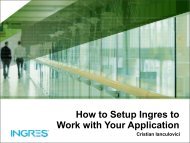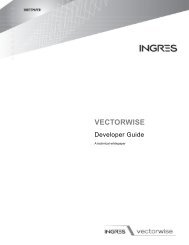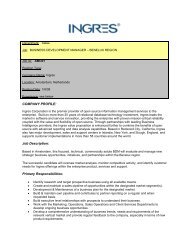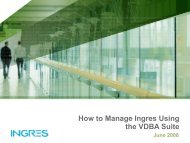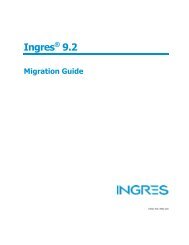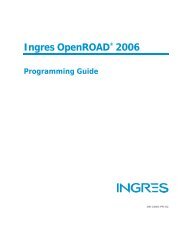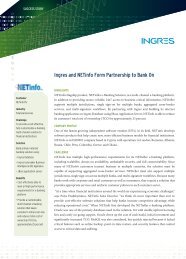What are Database Procedures? - Actian
What are Database Procedures? - Actian
What are Database Procedures? - Actian
You also want an ePaper? Increase the reach of your titles
YUMPU automatically turns print PDFs into web optimized ePapers that Google loves.
Smedley'sGuideTo<strong>Database</strong><strong>Procedures</strong>© 2007 Ingres Corporation (Ingres). All trademarks, trade names, services marks and logos referenced herein belong to their respective companies
<strong>What</strong> <strong>are</strong> <strong>Database</strong> <strong>Procedures</strong>? Code stored in the database Executed in the server Pre-compiled Executable code is a single transaction Composed of SQL statements Referenced objects must exist at create time Associated with database rules
Why Use <strong>Database</strong> <strong>Procedures</strong>? Performance Better than “repeated” SQL Reduced client/server communication Flexibility Easier to change Reusability, reduced coding time Integrity constraints, business rules
Why Use <strong>Database</strong> <strong>Procedures</strong>? Controls access to database objects– Only procedure owner requires privileges– Users only require execute on the procedure– Users do not require access to DBP objects Security is easier to manage– Data only changed via procedures– Less privileges– Easier still with roles and groups
<strong>What</strong> Not to Put in a DBP Unnecessary and complex code Unnecessary Variables Transaction control– Commit– Rollback Front-end work– Formatting data– Retry logic
<strong>Database</strong> <strong>Procedures</strong> Execution Called - 3GL or 4GL applications Executed - Interactive SQL Executed - database procedures Invoked - database rules
Parameter Passing By default Parameter passed BYVALUE Parameters can be passed BYREF Parameters can be passed– IN• The default mode• Equivalent to BYVALUE– OUT and INOUT• Equivalent to BYREF
Example in, out, inoutcreate procedure factorial_n( inout n integer, inout fac integer)asbeginif (n
Locking Strategy Locks taken when procedure starts Locks taken on all tables referenced No processing unless all locks in place Retakes locks after commit or rollback When an error rolls back to beginning ofprocedure
Debugging, Testing and Sizing Line numbers Sizing Message statement
Procedure: get_my_airlinescreate procedure get_my_airlines(alname nvarchar(60) )result row( nchar(3) not null, nchar(3) not null,nvarchar(60) not null) as decl<strong>are</strong> iatacode nchar(3);icaocode nchar(3);name nvarchar(60);begin for select al_iatacode, al_icaocode, al_name into:iatacode, :icaocode, :name from "smejo01". airline whereal_name like :alname do return row (:iatacode,:icaocode, :name);endfor;end;
Query Execution Plans Created when procedure is– Created– Loaded into server Stored in the Query Storage Facility QEP not based on full statistics– Max and Min statistics used in optimization
How Big is a QEP?register table imp_qsf_dbp (server varchar(64) not null not default is 'SERVER',dbp_index integer4 not null not default is 'exp.qsf.qso.dbp.index',dbp_name varchar(60) not null not default is 'exp.qsf.qso.dbp.name',dbp_owner varchar(24) not null not default is 'exp.qsf.qso.dbp.owner',dbp_size integer4 not null not default is 'exp.qsf.qso.dbp.size',dbp_dbid integer4 not null not default is 'exp.qsf.qso.dbp.udbid',dbp_usage_count integer4 not null not default is 'exp.qsf.qso.dbp.usage‘)as import from 'tables'with dbms = ima,structure = unique sortkeyed,key = (server, dbp_index)
Row Producing Procedure Must be called from an ESQL program Can return zero or more rows Row is defined by the Result Row clause The value returned in each “column” can be– A local variable– Parameter of the procedure– A constant
Example – Row Producing ProcedureExec sql begin decl<strong>are</strong>;intempid;intsales_rank;float sales_tot;…exec sql end decl<strong>are</strong>;…exec sql execute procedure emp_sales_rankresult row (:sales_rank, :empid, :tot_sales);exec sql begin;…exec sql end;…
Example – Row Producing Procedurecreate procedure emp_sales_rank result row (int, int, money) asdecl<strong>are</strong>sales_totmoney;empidint;sales_rank int;beginsales_rank = 0;forselect e.empid, sum(s.sales) as sales_suminto :empid, :sales_totfrom employee e, sales swhere e.job = ‘sales’and e.empid = s.empidgroup by e.empidorder by sales_sum descdosales_rank = sales_rank + 1;return row (:sales_rank, :empid, :tot_sales);endfor;end
Error BehaviourProcedure is not terminatedAll statements in the procedure up to the point of theerror <strong>are</strong> rolled backError is returned and iierrornumber is setContinues execution with the statement following thestatement that caused the errorParameters passed by reference <strong>are</strong> not updatedThe error is returned to the application in– SQLSTATE– SQLCODE– errorno
Row Counts and Errors iirowcount– Contains the number of rows affected by the lastexecuted SQL statement iierrornumber– Contains the error number associated with theexecution of a database procedure statement. Reflect the results of the preceding query Bew<strong>are</strong> of resetting the value
Return Terminates the procedure Can return an integer
Message Use the SQL message statement to returnmessages to users and applications Messages from database procedures can betrapped using– whenever sqlmessage statement– set_sql(messagehandler) statement Messages from database procedures canreturn to the application before the databaseprocedure has finished executing
Raise Error StatementUsed to describe database errors and violations ofbusiness rulesGenerates an errorThe Server responds to this error exactly as it does toany other errorReturns error number and customised message– raise error errornumber [errortext]errornumber– Is returned to sqlerrd(1)– Can be accessed using inquire_sql(dbmserror)
The Wrong Way to Error Check...update emp set ...;rcount = iirowcount;enumber = iierrornumber;…
The Right Way to Error Check...update emp set ...select iirowcount, iierrornumberinto rcount, enumber;…
Another Way to Error Checkupdate xyz . . . ;if iierrornumber != 0 thenrollback;message 17 'Update failed‘;return -1 ;endif ;
The Wrong Way to Error Checkupdate xyz . . . ;if iierrornumber != 0 thenmsg := ’Error updating xyz. ‘+ ' Error is ‘+ varchar(iierrornumber);mno := 1701;message :mno : msg ;return iierrornumber ;endif ;
The Wrong Way to Error Checkif iirowcount != 1 thenmsg := 'Bad rowcount updating table xyz'+ ', expected 1 but got '+ varchar(iirowcount);mno := 1702 ;message :mno :msg ;return iierrornumber ; /* failure */endif ;return 0 ; / * success */
Error Handling Simple is best Just check iierrornumber and iirowcount Error check as first statement in a DBP Return status only Let front end translate, report, display, log
Select Loopexecute procedure news_sorter;select * from news_sorted;
Select Loopcreate procedure news_sorterasdecl<strong>are</strong>next_id integer; /* next_id is the next id in the sorted table */brandinteger;news_id integer;headline varchar(100);linkvarchar(150);descvarchar(100);entered date;beginnext_id = 1;delete from news;for
Select Loopdoendfor;end;select brand, news_id, headline, link, desc, enteredinto :brand, :news_id, :headline, :link, :desc, :enteredfrom news_origwhere deleted = 0order by brand, news_idinsert into news_sorted (news_id, brand, news_orig_id,headline, link, desc, entered)values (:next_id, :brand, :news_id, :headline, :link, :desc, :entered);next_id = next_id + 1;
Session tabledecl<strong>are</strong> global temporary table session.news_sorted(news_order integer,brandinteger,news_idinteger,headlinevarchar(100),link varchar (150),desc varchar( 100),entereddate)on commit preserve rowswith norecovery;modify session.news_sorted to btree unique on news_order;execute procedure news_sorter(my_news_sorted = session.news_sorted);select * from session.news_sortedorder by news_order;
Session tablecreate procedure news_sorter(my_news_sorted = set of (news_order integer, /* next_id is the next id in the sorted table */brandinteger,news_id integer,headline varchar(100),linkvarchar(150),descvarchar(100),entered date))asdecl<strong>are</strong>next_id integer; /* next_id is the next id in the sorted table */w_brand integer;w_news_id integer;w_headline varchar(100);w_linkvarchar(150);w_desc varchar(100);w_entered date;
Session tablebeginnext_id = 1;delete from my_news_sorted;forselect brand, news_id, headline, link, desc, enteredinto :w_brand, :w_news_id, :w_headline, :w_link, :w_desc, :w_enteredfrom newsorder by brand, news_iddoinsert into my_news_sortedvalues (:next_id, :w_brand, :w_news_id, :w_headline, :w_link, :w_desc, :w_entered);next_id = next_id + 1;endfor;end;
<strong>Database</strong>Rules© 2007 Ingres Corporation (Ingres). All trademarks, trade names, services marks and logos referenced herein belong to their respective companies
Comparison Advantages of rules and procedures overconstraints and integrities -– More complex business rules– More control in handling violations– More control in handling errors– More flexibility in managing changes– Better use of resources
Things to avoid Multiple rules triggered by same action on atable Excessive rules cascading
Error Behaviour for DBP invoked by a ruleTerminates immediatelyReturns an errorStatements in the procedure which have beenexecuted <strong>are</strong> rolled backThe statement that fired the rule is rolled backNOT the same as an explicit rollback– just rolls back the statement, not the transactionsThe error is returned to the application in– SQLSTATE– SQLCODE– errorno
Rules Set [no]rules statement Rules <strong>are</strong> not fired by– Copy– Modify Set [no]printrules
Example of Before Rulecreate rule state_ins before insert into employeeexecute procedure state_ins (stcode = state_code,stname = state_name);create procedure state_ins( in stcode char(2), out stname char(12))asbeginselect st_name into :stname from state_codeswhere st_code = :stcode;return;end;
Questions & Answers








